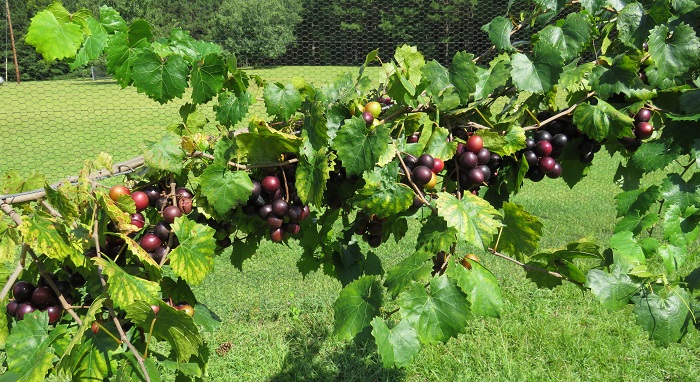
I know there are plenty of wild edibles out in nature, but there weren’t many that I found to be a decent food source. There were a few wild plums trees around that produced plums maybe the size of a quarter. We had dewberries, mainly along the banks of dirt roads. But, the thing we had the most of was muscadines, the Grape of the South. A lot of old-timers also call them scupnins, which is a variation of the word scuppernong. Scuppernongs are a specific variety of bronze muscadines, and the ones I’ve seen growing wild have been black varieties.
Native Americans used muscadines long before Europeans arrived, but we know they were ‘discovered’ by early colonists in North Carolina in the 1500s. They described the landscape as “so full of grapes that in all the world the like abundance is not to be found.” I wouldn’t say that about the wooded areas around here, but you could find them if you knew where to look. The challenge was getting to them as the vines frequently grew high up into the trees, trying to find sunlight. Of course, you could avoid that problem by growing them out in the open on a wire or trellis.
Although not quite in Dutchtown, much of the development of the muscadine has occurred nearby. Dr. B. O. Fry worked with muscadines at the Georgia Experiment Station in Griffin. When he ‘retired’ in 1968, he began working with the Ison family, who had been working with muscadines since 1934. That partnership led to the development of my two favorite muscadines, the Ison, which is a black variety and the Darlene, which is a bronze variety. The Ison’s still have a large nursery in Brooks today. Plant a couple of muscadine vines if you’d like to grow something that doesn’t take a lot of work and has a high degree of success. You can find more information about how to grow them at http://www.dutchtowngarden.com/muscadines/ or at www.isons.com.
Muscadines ripen in August and September. Because they have seeds and skin that’s hard to chew, we’d usually just pop them in our mouth, chew them up enough to get all the juice out, and spit out the rest. For boys always looking for trouble, it was usually too tempting not to pull off a few green ones and throw them at each other too. A little later on in life, our running trail through the woods had lots of muscadine vines in one corner. In September, the fallen fruit left a beautiful fragrance for you as you did each lap. A few weeks later and the decaying fruit left another distinctive odor. I would smell it again when my mother-in-law gave us a bottle of muscadine wine. I think I’ll stick with my muscadines before they go bad.
We will eat a few, but mostly we pick them and process the juice. Cheryl uses techniques she learned from Mrs. Ruth Aldridge to make jelly, so we’re able to enjoy our muscadines all year long.